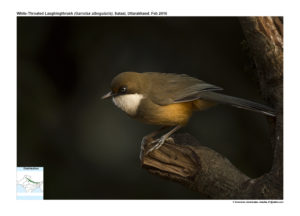White-throated Laughingthrush

White-throated Laughingthrush Garrulax albogularis
Etymology:
- Garrulax : Latin word garrulous –babbling, chattering; ax – inclining towards
- Albogularis :Latin wordAlbi – white ;Gulla – Throat { White throated}
Vernacular Names: Lepcha: Karriam-pho
Distribution in India: Resident of Himalayas in India.
Description: Size of 25-28 cm. It is a large, dull brown laughingthrush with white breast, rufescent-buff lower underparts and broad white tail tips. It has lower forehead to eye dull rufous, crown and upperparts are rufescent-tinged olive-brown, upperwing and central tail are similar but inner primaries fringed olive-greyish, outer primaries fringed pale grey, outer tail feathers with increasingly bold white tips and darker subterminally. The lores to cheek are blackish, ear-coverts as crown; chin black, throat to upper breast white, band across breast brownish-grey, continuous with but slightly paler and greyer than upperparts, broader at breast side, sharply divided from white but shading to ochraceous buff on rest of underparts . The iris is dull white through blue-grey to dark brown, orbital/facial skin is lead-grey; bill is horn-brown to black, sometimes paler tip; legs are slaty blue to dirty slate. Both the sexes are similar. The juvenile is rather warmer above than adult, with little rufous on forehead, orbital skin is greenish-yellow or greenish-olive, less pronounced breastband and whitish mid-belly, bill is blackish-olive, darker above, mouth is orange-yellow, gape is yellow.
Habitat: It is found in broadleaf evergreen forest, deciduous forest and coniferous forest, open secondary growth, scrub and light jungle. It breeds mainly above 1200 m, with some descent from highest levels during spells of harsh weather.
Food habits : It eats insects and outside breeding season also berries and seeds. It is gregarious, even in breeding season, occurring in flocks of 6–15 individuals up to 150 in non-breeding season. It feeds on ground; also in middle storey, where searches crevices of bark and tears off lumps of moss.
Breeding habits:
They breed in Mar–Jul in Himalayas. The nest is a broad shallow saucer to moderately deep cup, made of coarse dry grasses, dead bamboo or other leaves, ivy twigs with leaves attached, orchid leaves, creepers, twigs, roots, moss and lichen fibers, often well lined with rootlets, moss roots, red and black fern roots and fibers,above ground in bush, shrub, sapling or horizontal tree branch. They lay a clutch of 2–4 eggs. The nestlings leave nest long before full grown.